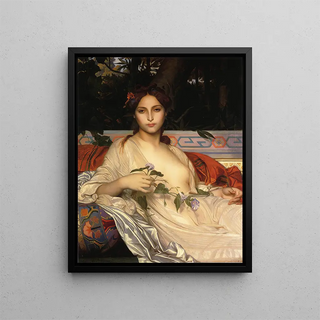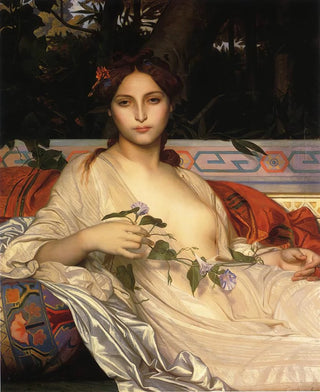Painting Albayde - Alexandre Cabanel | Art print


View from behind

Frame (optional)
Reproduction Albayde - Alexandre Cabanel – Captivating Introduction
The artwork "Albayde" by Alexandre Cabanel stands as a true ode to beauty and sensuality. A French painter of the 19th century, Cabanel is renowned for his ability to capture the very essence of femininity in his portraits. "Albayde" is no exception, offering a striking depiction of a woman who is both mysterious and enchanting. This piece, imbued with a romantic atmosphere, invites the viewer to immerse themselves in a universe where grace and elegance blend seamlessly. Gazing at this painting, one feels an immediate connection with the female figure, as if she were whispering secrets from another time.
Style and uniqueness of the art print
Cabanel's style is characterized by striking realism and a delicate color palette. In "Albayde," the finesse of details and the softness of features are remarkable. The light seems to dance across the skin of the central figure, accentuating her curves and highlighting the voluptuousness of her posture. The drapery of her clothing, carefully rendered, adds a tactile dimension to the art print, while the blurred background helps focus attention on the beauty of the subject. Cabanel skillfully plays with shadows and highlights, creating a sense of depth that brings his composition to life. The way he captures the emotions and thoughts of his characters is a hallmark that sets his art apart, and "Albayde" is a perfect illustration of this.
The artist and his influence
Alexandre Cabanel, born in 1823, was one of the most influential artists of his time. Trained at the École des Beaux-Arts, he quickly gained fame thanks to his works that combine academic tradition with innovation. His style, although deeply rooted in realism, also incorporated elements of romanticism, allowing him to transcend artistic genres. Cabanel influenced many artists, both through his technique and his vision of beauty. His approach to representing femininity, often idealized, left a lasting mark on art history. "Albayde" is not only a testament to his talent but also a reflection of the concerns

Matte finish

View from behind

Frame (optional)
Reproduction Albayde - Alexandre Cabanel – Captivating Introduction
The artwork "Albayde" by Alexandre Cabanel stands as a true ode to beauty and sensuality. A French painter of the 19th century, Cabanel is renowned for his ability to capture the very essence of femininity in his portraits. "Albayde" is no exception, offering a striking depiction of a woman who is both mysterious and enchanting. This piece, imbued with a romantic atmosphere, invites the viewer to immerse themselves in a universe where grace and elegance blend seamlessly. Gazing at this painting, one feels an immediate connection with the female figure, as if she were whispering secrets from another time.
Style and uniqueness of the art print
Cabanel's style is characterized by striking realism and a delicate color palette. In "Albayde," the finesse of details and the softness of features are remarkable. The light seems to dance across the skin of the central figure, accentuating her curves and highlighting the voluptuousness of her posture. The drapery of her clothing, carefully rendered, adds a tactile dimension to the art print, while the blurred background helps focus attention on the beauty of the subject. Cabanel skillfully plays with shadows and highlights, creating a sense of depth that brings his composition to life. The way he captures the emotions and thoughts of his characters is a hallmark that sets his art apart, and "Albayde" is a perfect illustration of this.
The artist and his influence
Alexandre Cabanel, born in 1823, was one of the most influential artists of his time. Trained at the École des Beaux-Arts, he quickly gained fame thanks to his works that combine academic tradition with innovation. His style, although deeply rooted in realism, also incorporated elements of romanticism, allowing him to transcend artistic genres. Cabanel influenced many artists, both through his technique and his vision of beauty. His approach to representing femininity, often idealized, left a lasting mark on art history. "Albayde" is not only a testament to his talent but also a reflection of the concerns
12,34 €






